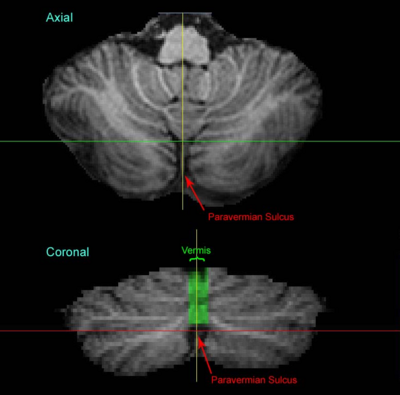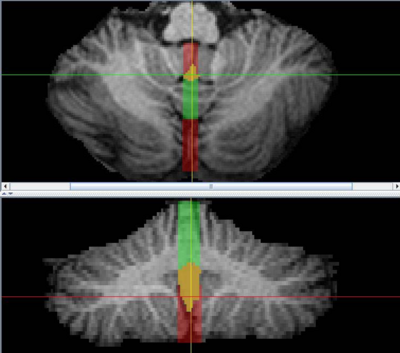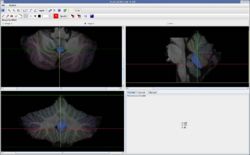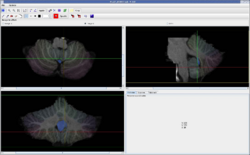Vermis Definition
<meta name="title" content="PAGE TITLE"/>
Contents
PAGE TITLE or OPENING HEADLINE
back to Protocol for Cerebellum Delineation
General Delineation of Vermis
The vermis is the region of the cerebellum separating the two hemispheres, and therefore lies in the mid-sagittal slices. Once the vermis has been located, the left and right hemispheres are relatively easy to locate and label.
The vermis can be located in several ways:
1. The vermal region of Lobule IX is nicely separate from the hemispheres and therefore can be located relatively easily (see the Lobule Identification section on Lobule IX vermis).
- In the Schmahmann book, IX_v exists (approximately) between sagittal slices X=-6 and X=+6
2. The vermis is also located by the following:
- The corpus medullare is much thinner in the vermis than in either hemisphere
- It is located in the sagittal slices near the connection of the cerebellum to the brain stem.
- Check axial and coronal views for the paravermian sulcus (see below)
3. Lobule I/II exists only in the vermal region, and therefore, any sagittal slices that contain this lobule can be considered part of the vermis
- The problem with this is that Lobule I/II is difficult to locate, and therefore finding a precise boundary of the lobule, and thereby the vermis is difficult
To best take advantage of #1, Lobule IX should be labeled first to help in locating the vermis and delineating the hemispheres and vermis (it is also easy to identify). Once IX_v has been delineated, most lobules in the same saggital slices should also carry the ‘_v’ label. However, care must be taken with the tonsils, and with lobules that span the paravermian sulcus (see below).
With the vermis located, the hemispheres can be delineated. Note that the left and right hemisphere labels should correspond the patient’s left and right.
It is therefore important to note the radiological convention – MRI images are usually oriented as though one is looking from the feet up the patient up towards the head. In this case, when viewing an axial or coronal images, the patient’s left is on the right side of the image, and vice versa. Make sure you are aware of the convention being used. To check the convention in MIPAV: Image -> Attributes -> View Header
Paravermian Sulcus
The paravermian sulcus is marked by the crosshairs in the figure below. It marks the separation of the hemispheres at the rear of the cerebellum.
The orange region in the figure below shows a previously labeled lobule IX_v. The green rectangles show the regions of the cerebellum that should be included in vermis labels. The red rectangles show regions that should NOT be included.
1. The tonsils should not be included in the vermal region (they belong to IX_L and IX_R). This is indicated by the upper (anterior) red rectangle in the axial image and the lower (inferior) red rectangle in the coronal image. 2. Furthermore, parts of the cerebellum that are on the edges of the paravermian sulcus should not be included in the vermal region. This is indicated by the lower (posterior) red rectangle on the axial image.
Anterior Lobe Vermis (I-V)
Posterior Lobe Vermis (VI-VII)
Inferior Lobe Vermis (VIII-X)
Lobule IX vermis
- Location: Within 10 slices to the left and right of the midsagittal
- Description: Vermis region of lobule IX, in the middle regions, it is the portion of lobule IX connected to the main branches of the cerebellum
- In the midsagittal, the vermis is slightly separated from the hemispheric section of the lobule (Figure 75)
- Best view(s) for delineation*: Axial/ Sagittal






